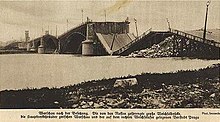Poniatowski Bridge
Coordinates: 52 ° 14 ′ 10 ″ N , 21 ° 2 ′ 30 ″ E
| Poniatowski Bridge | ||
|---|---|---|
| Official name | Most Poniatowskiego | |
| Convicted | Vistula | |
| construction | steel | |
| overall length | 506 m | |
| width | 21.40 m | |
| start of building | 1904 | |
| opening | January 6, 1914 | |
| location | ||
|
|
||
The Poniatowski Bridge ( Polish Most Poniatowskiego ) is a bridge in Warsaw . Originally built between 1904 and 1914, it was damaged in each of the two world wars and then rebuilt. It bridges the Vistula and connects Powiśle with the Praga district on the other side. Your viaduct is an extension of the Aleje Jerozolimskie .
history
The 506 m long steel bridge consists of eight support lengths and was designed by Stefan Szyller . Its construction began in 1904, was carried out by the K. Rudzki i S-ka company and supervised by engineers Mieczysław Marszewski and Wacław Paszkowski . Another engineer who worked on the bridge was Kazimierz Ołdakowski , who then took over the management of the Fabryka Broni . Nevertheless, the bridge for many was as extravagant considered (opponents of their construction were the mayor of Warsaw and the writer Boleslaw Prus ), it was on January 6, 1914 by the Russian Governor General Georgi Skalon as Warsaw's "Third Bridge" ( Polish Trzeci Most ) opened, since then "Third Bridge" has been her nickname. The city residents' official name was " Bridge of Our Most Gracious Ruler, Tsar Nicholas II " . Warsaw was then part of the Russian Empire as a result of the partition of Poland in the 18th century. After Poland regained its independence in 1918, the bridge was renamed after Józef Poniatowski and acquired a new nickname - " Poniatoszczak " - which it has kept to this day.
The structure suffered a lot during the world wars. The bridge was hastily rebuilt by the Germans - only to burn down again soon after in an accident. After the war, the structure was rebuilt by the Polish government over a period of five years, from 1921 to 1926. During the May coup , the bridge was the meeting point of the President of Poland Stanisław Wojciechowski and the head of the coup Marshal of Poland Józef Piłsudski . During the Second World War , the bridge was destroyed by German troops on September 13, 1944 during the Warsaw Uprising . This destruction was much greater by far: all the pillars had collapsed, only the low ones survived.
The first post-war plans of the new ( communist ) Polish government ensured that temporary wooden scaffolding was erected on the existing pillars, but hasty work caused the bridge to collapse. Restored on new pillars, the bridge was reopened on July 22, 1946 by Bolesław Bierut .
In 2004 a program of reconstruction and beautification began for the bridge. By 2005 the small towers and the first four columns had been rebuilt. The tramway was modernized and rebuilt in 2007.
Individual evidence
- ^ One Unlucky Bridge , Warsaw Voice, July 1, 2001
- ↑ Messter Week - Films from the Federal Archives. Retrieved June 17, 2018 .



